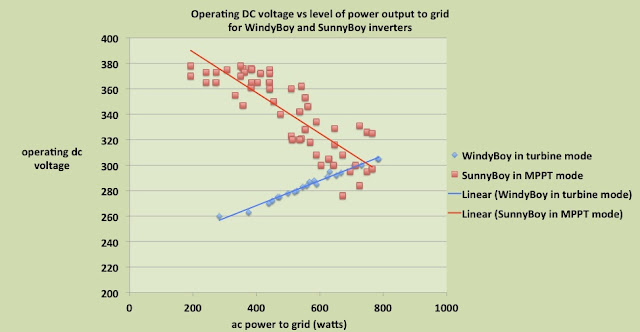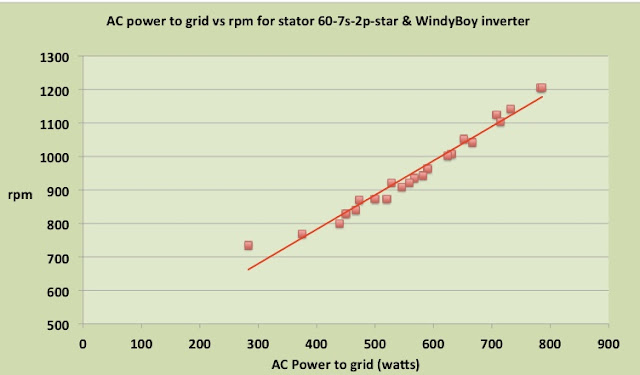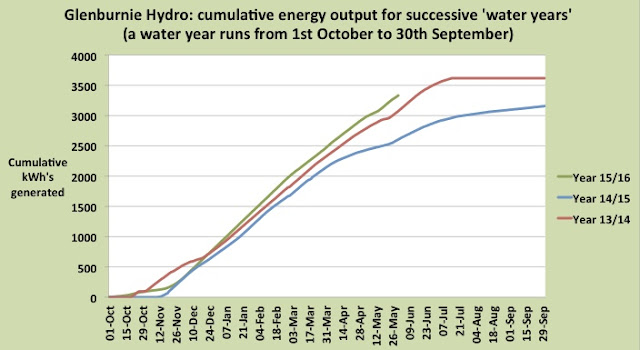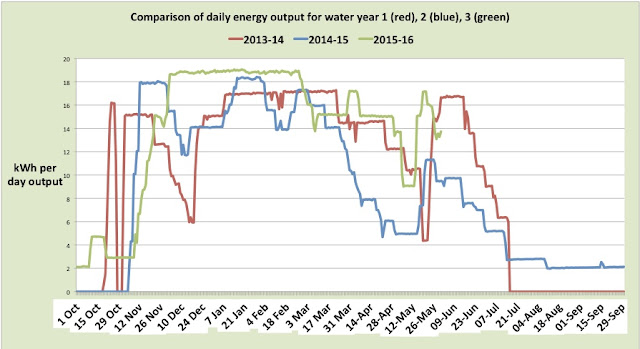The development that prompted my comment was when I started using a WindyBoy instead of a SunnyBoy inverter and came to see that the WindyBoy, quite unlike the SunnyBoy, caused the turbine to operate at a lower voltage at times when flows were small.
This was a startling difference and the plot below shows it. As can be seen, with diminishing power the SunnyBoy's operating voltage progressively rises, whilst the WindyBoy's progressively falls.
The significance of this was great: up until this time I had always operated with a SunnyBoy using MPPT mode and it had caused me problems in the dry months.
In the first summer, from beyond the middle of July, the operating voltage rose to be too high to keep the turbine running. In the following year, having obtained an 18 pole stator to use in place of the 42 pole one, voltage was kept down and this enabled generation to continue all through the second summer. But there was the hassle of needing to change stators. My excitement about the WindyBoy came from anticipation that I might in future be able to keep operating without need of having to change the stator.
So how are things working out ? - not quite as promisingly as hoped is the short answer!
The issue centres on speed. Whilst WindyBoy does keep voltage lower it does so by imposing such load on the SmartDrive that shaft speed is reduced significantly. This effect can be seen in the plot below:
The problem with this reduction in speed is that it makes the pelton operate at an rpm where maximum energy is not extracted from the head and flow available.
One way around the problem is to re-program the 'table' in the inverter, by which I mean re-program the algorithm it calls upon to work, to make it draw less current from the pma* for a given voltage when it is working at the lower end of its range. This can be done, I think, and I'm beginning to explore how to do it.
Another way which is simpler is to tinker with the SmartDrive. By placing a packing washer on the shaft so that the rotor is made to stand off a bit when the knob is fully tightened, the operating rpm is lifted back toward the speed at which the pelton functions most efficiently.
Doing this is not, strictly speaking, increasing the air gap as is commonly done with axial flux pma's to adjust their output. Rather, in a radial flux, "brake drum" type pma which the SmartDrive is, it is degrading the flux linkage between the rotor field and the poles of the stator**. But it has the same effect as increasing the air gap, which is to reduce the voltage generated at a given rpm, or, as happens when feeding the output to an inverter in turbine mode, giving the same voltage at a raised rpm.
A few days ago when I put in the O-ring illustrated, the rpm was lifted from 829 to 897 and with this, the ac watts output from 449 to 462. No other change was made which might have confounded these results, and in particular the hydraulic parameters powering the pelton were identical before and after fitting the O-ring.
When I went on to put two such O-rings in, the effect was not beneficial at all: ac watts became worse than with no O-ring despite rpm having risen to almost exactly the theoretical optimum speed for a Powerspout pelton on my site. The explanation for this is that the gain from the pelton operating at its 'sweet spot' speed was outweighed by poorer performance from the SmartDrive. So the method is not straightforward. It involves trial and error to find how much packing will benefit pelton performance before that benefit is cancelled by degraded performance from the SmartDrive.
Summer is still in its early stages here in Wales. It's still too early to say whether my excitement 6 months ago about operating with WindyBoy in the dry months was premature. I'll see how things go as flows diminish further and continue to play around with rotor packing.
The experiment I have running in parallel, of operating with variable head, seems to be going OK. It allows a much more 'hands off' approach to changing nozzles as flow diminishes, and significantly, it allows use of all the flow.
The stimulus behind all these efforts is to squeeze as many kWh's out of this 'low flow' time of year as I can, - all in the hope I'll hit my 4 MWh total for the year!
*pma = permanent magnet alternator
** more exactly it is reducing the area of the gap field



